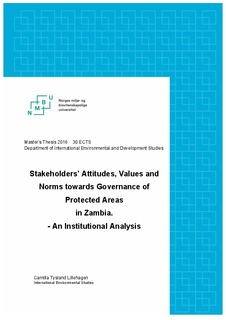| dc.contributor.advisor | Vedeld, Pål Olav | |
| dc.contributor.author | Lillehagen, Camilla Tysland | |
| dc.coverage.spatial | Zambia | nb_NO |
| dc.date.accessioned | 2017-06-06T12:05:23Z | |
| dc.date.available | 2017-06-06T12:05:23Z | |
| dc.date.issued | 2016 | |
| dc.identifier.uri | http://hdl.handle.net/11250/2444443 | |
| dc.description.abstract | Zambia has acknowledged the need to improve the livelihood of people living in or near protected areas, in order to decrease illegal use of natural resources. Community Based Natural Resource Governance Management (CBNRM) is seen as a possible solution, as it promises to increase the livelihoods of the local communities by involving them in resource governance. CBNRM was therefore institutionalized in the Zambian Wildlife Act in 1998 and is currently part of their conservation strategy for protected areas including Game Management Areas (GMA). However, the approach has not delivered the promised results.
To study why this approach is not succeeding in Zambia, this field study focuses on the environmental governance regime in Namwala GMA outside Kafue National Park. Semi-structured interviews are used to gather both qualitative and quantitative data. The study focuses on identifying the limitations and challenges in the regime to understand how improvements can be made, with emphasis on stakeholders’ attitudes, values and norms and how these characteristics influence different stakeholders in the assessment of governing the valuable resources.
The results from this research include limitations in the resource regime that hampers the interaction between different stakeholders and causes poor management. Both local people and natural resources are still suffering from poor management and the community-based approach is not implemented sufficiently. Local people are often unaware of the policy governing the area and the participation structure that is supposed to include them in governance and thus improve their livelihood. The management and staff are unable to build capacity, share benefits and devolve authority to the complex local institution. Negative attitudes exist between the local community and the management and staff, due to poor management of illegal activities. Evidently, not much has been done in Namwala to implement CBNRM and the GMA is still managed through a top-down approach, marginalizing local people. For CBNRM to deliver, it is necessary to build capacity and competence among management and staff so they are capable of initiating actions recommended by CBNRM. They also need to consider the social structures and informal rules in individual GMAs, to involve local people in governance of natural resources. | nb_NO |
| dc.language.iso | eng | nb_NO |
| dc.publisher | Norwegian University of Life Sciences, Ås | nb_NO |
| dc.rights | Attribution-NonCommercial-NoDerivatives 4.0 Internasjonal | * |
| dc.rights.uri | http://creativecommons.org/licenses/by-nc-nd/4.0/deed.no | * |
| dc.subject | Resource governance | nb_NO |
| dc.subject | Game Management | nb_NO |
| dc.subject | Namwala | nb_NO |
| dc.subject | ZAWA | nb_NO |
| dc.title | Stakeholders' attitudes, values and norms towards governance of protected areas in Zambia : an institutional analysis | nb_NO |
| dc.type | Master thesis | nb_NO |
| dc.subject.nsi | VDP::Samfunnsvitenskap: 200::Demografi: 300 | nb_NO |
| dc.source.pagenumber | 152 | nb_NO |
| dc.description.localcode | M-IES | nb_NO |

